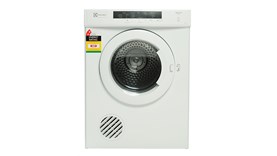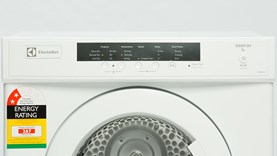Electrolux EDV6051 review
Vented clothes dryer. 6kg capacity. Priced at $669.


Good points
Bad points

Unlock our expert review and more
- Reviews and ratings you can trust
- Easy side-by-side comparison
- Recommended products at a glance
-
Type
View more details.
Whether the dryer is a vented, condenser or heat-pump model. See our clothes dryers buying guide for an explanation of each type.
- Vented
-
Recommended
View more details.
We recommend heat pump and condenser dryers with a CHOICE Expert Rating of at least 80%, an efficiency score of at least 80%, and a drying time score of at least 70%. For vented dryers, we recommend models with a CHOICE Expert Rating of at least 75%, efficiency score of at least 65%, and a drying time score of at least 80%. If a dryer cannot achieve 6% or lower moisture content in the clothes within its program time, we won't recommend it.
-
CHOICE Expert Rating
View more details.
The CHOICE Expert Rating, the overall score that determines which products we recommend, is made up of energy efficiency (50%), drying time (40%) and drying performance (10%). Weightings are in brackets.
-
Drying time score
View more details.
If the dryer has a sensor to determine when the clothes are dry and automatically turns off, we use it, otherwise we test using the timer.
-
Energy efficiency score
View more details.
We measure how long it takes to dry 3.5kg of washing (6.65kg when wet) and how much energy is used. The energy efficiency and drying time scores are based on the amount of energy and time used per kg of clothing.
-
Drying score
View more details.
The drying score reflects the level of moisture in a load after a cycle. The resulting moisture level should be neither too dry or too moist.
-
Final moisture content (%)
View more details.
The percentage of moisture content after a drying cycle. Moisture content between 4-4.5% is ideal with anything up to 6% also considered very good. Moisture content below 2.5% may reduce the life of some garments and over 6% may appear to be not as dry you would expect.
-
Cycle time (min)
View more details.
How long the cycle took on the program we used.
-
Noise (dBA)
View more details.
The maximum noise level is measured one metre away from the machine and one metre above the ground. Typically, the noise level of these machines is similar to that of a normal conversation (about 50-65dBA). It's not an absolute noise measurement - the acoustics of your home will determine exactly how a machine sounds in use - but it's a good comparative measure.
-
Measured energy used/load (kWh)
View more details.
The amount of energy used by the program we selected for our test. Clothes can make up to 3.7% of your average household's energy usage, so look for the lowest number to avoid paying more for your energy than necessary.
-
Full load program time (min)
View more details.
This is the time the manufacturer claims the dryer will take to dry a full-capacity load. This differs from the time we measure in our testing, which is based on a standard 3.5kg load.
-
Shop Ethical rating
View more details.
Shop Ethical rates the environmental and social impact of the company (not the product) using independent sources. This rating is not included in our total score. N/A means there is no rating for that company.
- C
-
Energy star rating
View more details.
Claimed by the manufacturer. The higher the number, the more energy-efficient the dryer.
- 2
-
Claimed energy use (kWh/year)
View more details.
Energy use claimed by the manufacturer, based on a full load and 52 uses per year.
- 267
-
Reliability score
View more details.
A high score means the brand (not the model) is less likely to have faults over time, according to CHOICE members.
-
Satisfaction score
View more details.
A high score means CHOICE members are satisfied with the brand (not the model).
-
Warranty (years)
View more details.
Stated warranty of the dryer. You're still covered by the Australian Consumer Law regardless of the manufacturer warranty.
- 2
-
Country of origin
View more details.
Where the dryer was manufactured, though parts may have been sourced from other places.
- Thailand
-
Price
View more details.
The manufacturer's recommended retail price. Prices are generally always flexible, so shop around both online and in bricks-and-mortar stores for options.
- $669
-
Running cost over 10 years
View more details.
Based on drying a full load about three times a week (150 times a year) for 10 years, calculated at 40c/kWh. Clothes dryers can make up to 3.7% of your average household's energy usage, so look for the lowest number to avoid paying more for your energy than necessary.
-
Capacity (kg)
View more details.
The manufacturer's claimed capacity. This is the weight of the laundry when dry.
- 6
-
Are controls inaccessible when dryer is inverted?
View more details.
Sometimes if a dryer is wall-mounted it needs to be turned upside down, which can put the controls out of reach. When this criteria has a No, it means the manufacturer either supplies a sticker for the dryer that indicates how to use the inverted controls (this is called a mounting kit - not to be confused with mounting brackets), or it shows the controls in a sensible fashion both right side up, and upside down.
- No
-
Exhaust location
View more details.
Where the exhaust is located on the dryer that releases moisture and/or heat into the air.
- Front or rear
-
Ducting kit
View more details.
If the ducting kit is supplied with the dryer.
- Optional
-
Drying rack supplied
View more details.
Whether the drying rack is supplied by the manufacturer.
- N/A
-
Filter location
View more details.
Generally the filter will be in the front of the door or on the front of the dryer. Manufacturers have moved away from placing filters in awkward positions such as the rear of the drum.
- Inside front
-
Dimensions (cm, H x W x D)
View more details.
The dimensions listed are the smallest figures stated by the manufacturer. The installation space given is the smallest dimensions in which the dryer is claimed to fit.
- 80 x 60 x 62
- Website
- electrolux.com.au
-
Auto-sensing
View more details.
An auto-sensing program means the dryer will stop when it senses the load is dry.
- Yes
-
One-touch start
View more details.
One-touch start means you pop your clothes in, press start and the dryer does everything for you. Most basic machines won't have anything like this and will require at least a couple of presses to get the machine started (power, program, start).
- No
-
Iron-dry program
View more details.
An iron-dry program leaves the clothes a little damp so they're easier to iron. The ironing process will make the remaining moisture evaporate.
- Yes
-
Cupboard-dry program
View more details.
Clothes should come out dry enough to put straight into the cupboard.
- Yes
-
Extra-dry program
View more details.
A longer program for multi-layered or thick fabrics such as bed sheets, towelling bathrobes or socks.
- Yes
-
Timed drying
View more details.
This means instead of or in addition to a sensor, you can turn the knob of the dryer dial to choose how many minutes the dryer will run.
- Yes
-
High temperature program
View more details.
You select high for drying cottons and low for heat-sensitive fabrics. Check the icons on your clothes' care labels for which to use.
- Yes
-
Low temperature program
View more details.
You select high for drying cottons and low for heat-sensitive fabrics. Check the icons on your clothes' care labels for which to use.
- Yes
-
Woollens program
View more details.
This is for tumble drying woollens or delicate fabrics with gentle heat and minimal tumbling.
- No
-
Anti-crease program
View more details.
Some dryers will make the drum move occasionally after the end of a cycle until you open the door. This is to stop creases from forming in the clothes.
- Yes
-
Delay-start feature
View more details.
This allows you to delay the start of the drying cycle, meaning you can set the dryer to come on later in the day to take advantage of solar power, or at night to take advantage of off-peak rates.
- Yes
-
Stackable
View more details.
Generally most dryers can be stacked on top of a front loading washing machine, but some require stacking brackets, sold separately.
- Yes
-
Stacking kit supplied
View more details.
It's uncommon for manufacturers to include a stacking kit with their dryer, more likely it will be an optional extra you'll have to purchase after the fact. They can range in price from $30 to over $100.
- No
-
Wall mountable
View more details.
Most vented dryers can be wall-mounted, but you may need to buy mounting brackets separately. Condenser and heat-pump dryers are generally too heavy for wall-mounting.
- Yes
-
Wall mounting brackets supplied
View more details.
The manufacturer supplies brackets for models that can be wall-mounted.
- Yes
-
Drainage hose
View more details.
For condenser and heat pump dryers, a drainage hose solves the issue of having to empty the drainage container that collects the waste removed from clothing. Not all dryers come with this option.
- N/A
-
Reverse tumbling
View more details.
Stops every few seconds and reverses the tumbling action so the clothes don't bunch up. This is important because without reverse tumbling, large towels and sheets can wad up into a tight ball and not dry properly. Reverse tumbling also helps limit creasing.
- Yes
-
Unit starts on door shut
View more details.
Some machines will start when you shut the door (though they're rare) which can be a danger when you have children or pets.
- No






